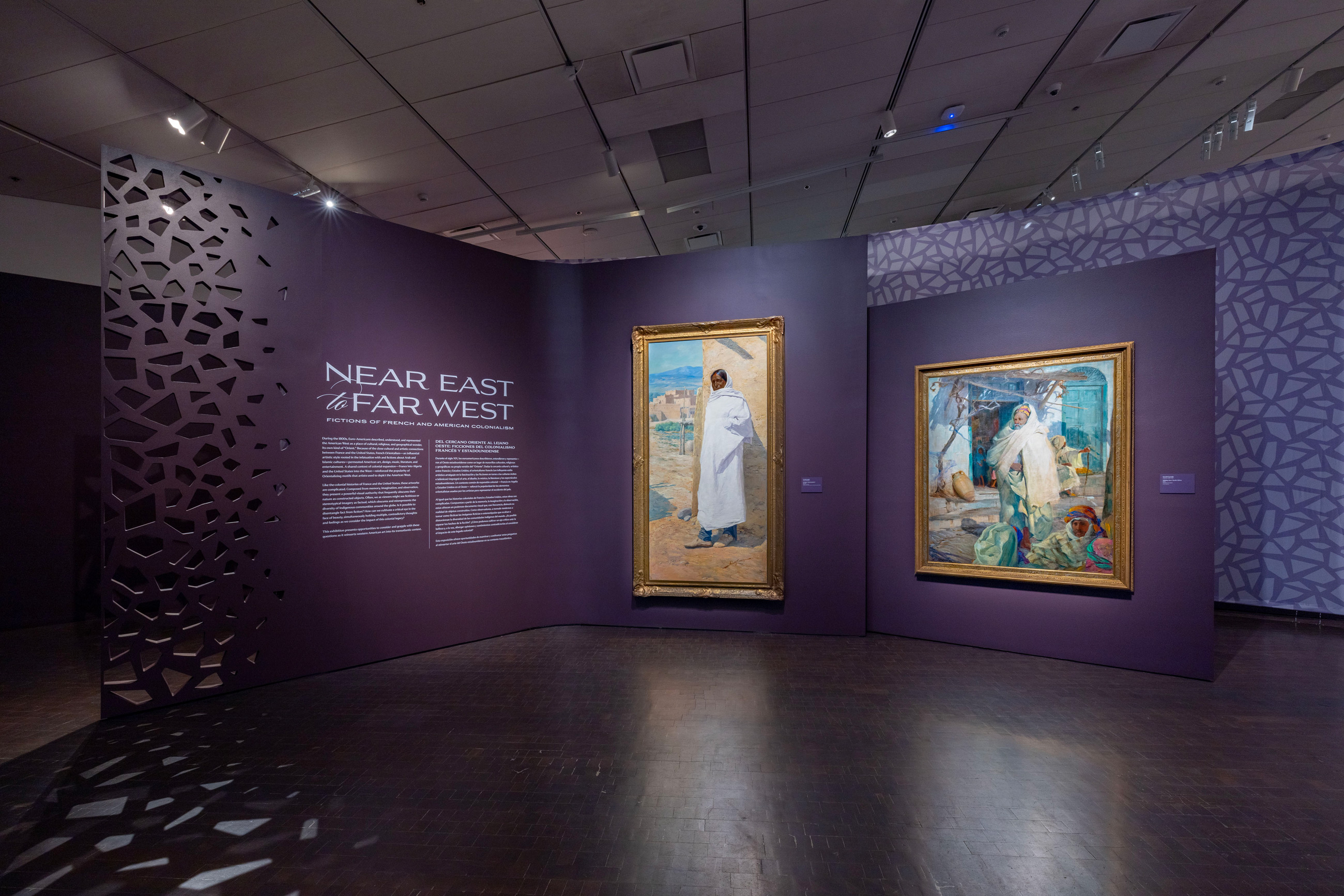
Left to right: Gerald Cassidy, Cui Bono?, about 1911. Oil paint on canvas; 93 1/2 × 48 in. Collection of the New Mexico Museum of Art: Gift of Gerald Cassidy, 1915 (282.23P). Gerald Cassidy, Midday Sun, North Africa, 1920s. Oil paint on canvas; 64 × 51½ in. Private collection.

Left to right: Charles Théodore Frère, Along the Nile at Giza, date unknown. Oil paint on canvas; 38 × 51 in. Dahesh Museum of Art, New York. 1995.102. Fernand Lungren, In the Abyss: Grand Canyon, about 1896. Oil paint on canvas; 60¼ × 40 in. The Art, Design & Architecture Museum, University of California, Santa Barbara: Fernand Lungren Bequest, 1964.659

Reflection space with scents by Dana El Masri.
Artworks in Near East to Far West: Fictions of French and American Colonialism (through May 29) present a range of representations from sympathetic to stereotyped. Indeed, racialized stereotypes such as the “Noble Savage” and odalisque (a woman in a female-only domestic space, or harem, who is often overly sexualized in European art) circulated throughout French Orientalism and western American art. Acknowledging the ongoing harm of such representations, we knew that we needed to make space for diverse perspectives: essentially, to make room for the voices too often repressed or ignored in the artwork.
Scholarly feedback
A National Endowment for the Humanities development grant funded external scholars Emily C. Burns, Robert Warrior (Osage), Jennifer W. Olmsted, and Jacob Rama Berman, in addition to John Lukavic and Dakota Hoska (Lakota), curators in the DAM’s department of Indigenous Arts of North America. These consultants provided feedback on the development of the entire project—including the exhibition, publication, and programs—and helped surface some of its pressing concerns, such as the legacies of stereotyped representations in the present and the possibilities and pitfalls of exhibiting historical colonial artworks.
Community insights
The NEH development grant also funded a series of focus groups composed of diverse members representing Indigenous, LGBTQ+, Muslim, and Arab communities who considered the artworks and the main themes of the exhibition. Many of their insights are represented in the exhibition as Community Labels (read them on our online Access Guide). These comment on a range of topics including the fuzzy line between fact and fiction, concerns about European and Euro-American representations of women and people of color, and stereotypes. Additionally, we hired Indigenous, Arab, and Muslim readers who reviewed and edited exhibition text.
Artist responses
We also commissioned three contemporary artists to respond to the project. Perfumer and interdisciplinary artist Dana El-Masri created two custom scents for the exhibition’s reflection space. One of these, in her words, aims to strip away the romanticism at the core of Orientalism. With the other, she hopes to bring a new perspective that gets away from fantasy and honors forgotten narratives. These scents, in addition to prompts about the legacies of Orientalism and the meaning of home, help visitors reflect.
Poet Jennifer Elise Foerster (Mvskoke) wrote a hauntingly beautiful poem in response to the artworks in the exhibition, and multi-disciplinary artist Steven Yazzie (Navajo/Laguna Pueblo) and his team created a video to accompany Jennifer’s poem using AI technology that selects, appropriates, and modifies source material in a way that echoes the creative process of nineteenth-century artists.
Internal input
We also sought internal input. A group of gallery hosts participated in focus groups and helped us better understand how to deliver and contextualize challenging information for our audiences. Because of their familiarity with our gallery spaces, they also helped us understand how the physical space might aid—or not!—the work we're trying to do with this show, highlighting where certain areas are prone to bottlenecks and pointing out where text interpretattion may be best positioned.
Our EDI Committee reinforced the importance of highlighting underrepresented perspectives. Our Indigenous Advisory Council provided regular feedback on exhibition content and concerns related to historical trauma in their communities. Members of the project team with which I have been honored to work—Meg Selig (Curatorial Assistant), Eric Berkemeyer (Project Manager), Valerie Hellstein (Managing Editor), and Lauren Thompson (Interpretive Specialist)—have played important roles in these collaborations.

